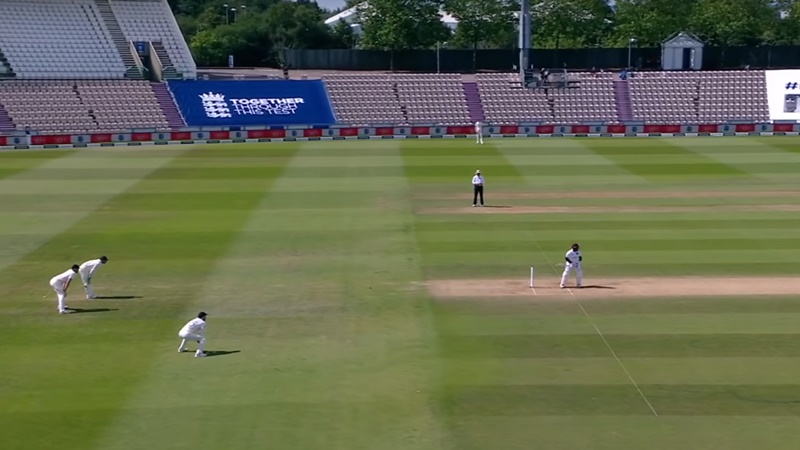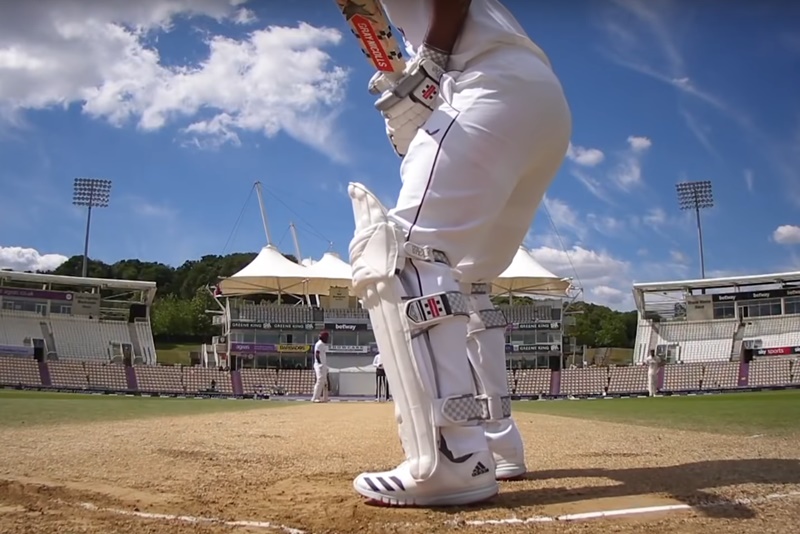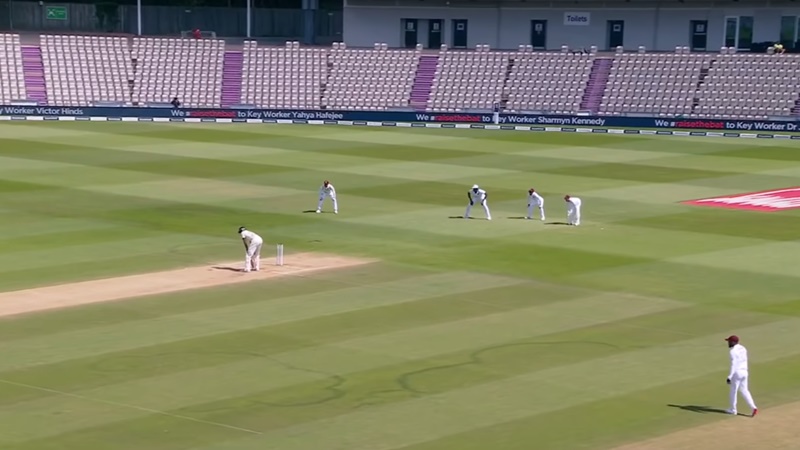With no fans allowed inside cricket grounds due to the coronavirus crisis, Sky Sports and Test Match Special have been broadcasting fake crowd noise for atmosphere. Could they be doing a better job with this?
Crowd noise is very important in cricket. It’s important for atmosphere, obviously, but it can also help you follow the game. If you’re in the next room, making a brew, a crowd roar can alert you that something significant has just taken place. (At this point we can’t help but reprise our moan about the modern trend for playing replays with all of the original crowd noise. Noisy replays are the bane of our life and have now disappointed or falsely alarmed us somewhere around 10,000 times.)
Ahead of the first Test, we suggested that it would be worth paying attention to what the match sounded like. With no spectators allowed in the ground, both Sky and the BBC played ambient crowd noise in a bid to make the whole thing seem slightly less weird.
On an anticlimactic first day, with the players regularly on and off for bad weather, that ambient crowd hum didn’t seem quite right to us. We felt that they were using “Sunny Sunday” crowd noise when they should have been using “Rainy Wednesday.”
On the Friday, when the sun came out, that same murmur seemed a better fit. But even then it remained the same, no matter what was happening on the pitch. That is not how crowds sound. Even within the same day, a morning session does not sound like an evening session for reasons.

Matthew Share, a freelance Location Sound Mixer who actually pitched for this bizarre audio job, took some time away from Celebrity Gogglebox to talk to us about it.
Matthew thought the audio they used on Test Match Special (TMS) and Sky during the first Test was “pretty okay in the circumstances,” but he felt they could have done more.
“There’s actually quite a lot you can do with recorded ambience of crowd noises,” he explained. “The football uses the EA Sports Fifa audio engine to produce swells of noise for exciting moments and a variety of opprobrium sounds for bad tackles, missed shots and players defecating on the pitch.
“I had a chat with the people at CTV, who broadcast it for Sky, about doing exactly this job for the cricket. I sketched out a rough plan for it that would’ve meant I’d pull together a whole library of recorded ambience, including all the Barmy Army songs and specific sounds for different types of dismissal. I’d then play them into a general hum depending on what session we were in, and what the game was doing.
“It might well have been awful to listen to, but I’d have gotten to go to the cricket and have a laugh at my job so I’m a bit sore they didn’t follow through.”
While it does indeed sound fun, it also seems like an incredibly demanding job for a person to carry out. Watching intently, making decisions and not missing a thing – that’s basically umpiring, isn’t it?
“Yes, it would be quite a full-on job,” agreed Matthew. “I think that’s partly why it didn’t materialise.”

He doesn’t think it’s an impossible task though.
“I like cricket, so the rhythms wouldn’t be beyond me, and if you had a constant track of spectator hubbub underneath all the additional sounds and used subtle changes for the moments of interest, and made sure none of them were too pronounced, I think you could do a good job of it.
“The idea would be to distract from the lack of sound – trainers squeaking, bowlers farting as they release the ball and players clearing their throat on to the outfield – rather than to play every sound that you’d get with a crowd.”
There are many different flavours of crowd noise. It’s fun to think about some of the more specific ones, like ‘hit in the nads’ or the rising crescendo you get when a bowler’s running in on a potential hat-trick ball.
Matthew said: “I had all the Barmy Army songs ready to go, as well as my personal favourite; a slow building, ‘oooooooohhhhh, oh!’ from the crowd that you could use for balls being chased to the boundary.”
There are obvious dangers in being able to trigger ‘sustained cheering’ instead of ‘LBW turned down’. We suggested that the job was almost akin to learning to play an instrument.
“I was looking to have a bank of effects, which would have been assigned to a series of pads that you hit to trigger them,” he explained. “Arrangement of these would have been the key; reactions, atmos, positive reactions, negative reactions, ooohs and aaahs.
“It’s a fairly common way of working for grams operators in theatre and live TV. Remember Tiswas and Vic and Bob using extreme sound fx for comic effect? That was someone sitting in a room with a similar setup.
“The speed of learning the bank of fx is down the individual. It’s not what I do day in, day out but I’ve done it before so I’d have probably been somewhere in the middle.
“I’m guessing each day would have different challenges. Day one of the Ageas Test would have been crazily stabbing the reaction pads as England wickets tumbled, but day four would have been a very different beast.
“I’d have saved the biggest reactions for the wickets of Stokes, a sad sigh for Pope going, a slightly amused cheer for Blackwood.”
Matthew said he got very excited at the prospect of “riding the faders” for a Test match and isn’t giving up yet.
“I’m trying to work out a way of doing all this, and combining it with calling front foot no balls. Basically inventing jobs I can do that take me to the cricket.”



The crowdless cricket has been a challenge for the doing-something-else mode of test match watching. Normally when stacking the dishwasher or home educating a daughter, the crowd reaction is the cue to glance at the iPad .
However for the last two tests, the cues have been different, whether a Vaudeville bray of excitement from Bumble, a slight raise in tone from Athers, or a change in the timbre of piss-take from Rob Key. Not only are they less distinctive, but they are less visceral than crowd noise. And less instantaneous as even the first reaction requires the commentator to think and articulate, rather than just give a bestial roar.
I do think the current situation is better than manufactured reaction though. The low key burble is there, as I understand it, to be less obtrusive than silence. Adding playbacks of MCC establishment applause, ersatz Barmy Army brass section or me and my mate Alan going mental at Headingley last year would somehow ring false.
Surely it’s a question of degree. To our ear the unchanging tone at the fall of a wicket rings more false than a swell in volume would.
My worry (I always have a worry) is that once you allow artificial noise, is there then an incentive to start adding it for away tours in the UAE, or in countries where not many people go to Tests?
It’s a bit like a nature documentary where they have staged scenes or edited things to produce a false ‘narrative’ – I prefer the lack of ‘entertainment’ to a lack of accuracy/veracity in a documentary, and I feel the same about ‘factual’ sport coverage.
One thing that I have been mildly surprised by when discussing this topic, however, is the extent to which TV coverage already uses (ahem) ‘enhanced’ sound for sport – rowing (splash splash) and horse racing (allegedly involving recordings of stampeding buffalo) in particular….
I agree. Even if the counterfeit crowd noise improved the instant of the splendid cover drive or ripping inswinger, I would feel a bit cheated when my intellect caught up with my emotions and I realised that it was canned applause.
Apparently the TMS background hum is on a loop and there is a high-pitched laugh at the end which comes back around every few minutes.
Imagine being the tiny digital being living in that purgatory, having to perfectly recreate that laugh every few minutes.
I am that tiny digital being. Three back to back test matches is murder.
I went to the 2002 Ryder Cup at the Belfry, for the final day singles. After some wandering around, we sat down in the grandstand by the 16th green to watch the matches come through. This was 2002, before electricity had been invented, so there was no big screen as there is now at every green. There was a big scoreboard, with pegs on it, and a man in a chair who would hang AS, 1-Up, 2-Up, etc against the players’ names as the scores changed.
After two matches came through, there were matches on all the holes anywhere near us. After a while, we (and everyone else) became adept at deciphering the noises from different directions and working out what had just happened. It went like this:
Right and slightly behind – 18th green
Right and distant – 17th green
Straight ahead – 15th green
Slightly left – 11th green
Left and close – 10th green
Massive cheer – holed European putt for birdie
Some oohs, then polite applause – holed American putt for birdie
Building noise, then oohs – missed European putt, but close
Big cheer, suppressed, then restrained applause – missed American putt
Just applause – regulation American win
Sustained cheering for a minute – European win
There were more, of course, each with nuances depending on the expectedness and significance of the event. We probably had about a dozen decipherable crowd noises to work with.
So we would be sat waiting, when suddenly a huge cheer would erupt from roughly the 45 degrees right direction. 17th green, we surmised, Bjorn vs Cink. He had left the 16th at 1-up, so this was a place where things might be happening. If Bjorn had holed his put for a birdie, this could be big. Silence, on their green and ours, for a minute or so. Clearly the American was taking his time over what was a crucial putt. Then, an eruption of noise, suppressed slightly as the players probably shook hands, then erupting again as Bjorn probably did a fist-pump and a dance on the green.
This whole picture came from the noise. With exquisite timing, enough to be clearly deliberate, the scoreboard man would then leave his chair, take an unseen board from a box, and climb the ladder to the scoreboard. He took down the 1-Up next to Bjorn’s name. What would replace it? A 2-&-1 as we had deduced? Or an AS? Oh god, they’ve dragged it back, all square going up the 18th. But no, that can’t be, because the noises wouldn’t make any sense. It had to be a win, surely it had to be a win…
It was genuinely the best day of sport watching I had ever experienced, and almost none of it was actual watching. It was 50% an aural experience, 50% an imagined experience. A big screen would have ruined it.
That is beautifully described Bert. Chapeau.
Golf’s not my thing, but Daisy and I have had similar experiences at Wimbledon when watching a match on one show court while a nail-biter is going on across the way in the other main show court.
But of course what you have described so beautifully there, Bert, is the authentic sound of a crowd and also the effect it has on the senses when you are physically proximate to the sound.
One thing I am really missing at the moment is live music. Of course I can listen to wonderful recorded music, but the effect that live sound has on the senses touches the soul in a way that recordings (and certainly canned crowd noise) simply could never achieve.
fake noise is both ecttremely silly and rather annoying. it is as bad as fake laughter tracks on those rubbishy american comedies
Laugh tracks are dismal. Fan tracks come from the same primitive, condescending space. I only want to hear the game—not what engineers, (or worse,) producers, or (still worse,) marketers feel the game should be. I resent the attempt at having my reaction dictated by a click track.
Part of the problem at the moment is that the commentators are not performing at their best and certainly are not adapting to the current circumstances.
On the TV, no-one said a word for ages when Stokes caught & bowled Brathwaite on Sunday. Daisy and I had just got back from doing our FoodCycle deliveries; half-watching, half-chatting as we do.
We had time for the following conversation before a commentator said a thing:
GED: That’s out!
DAISY: What? No? How?
GED: Caught & Bowled! Ben Stokes! Brathwaite! That could be…
(…commentator wakes up and starts saying something…)
GED: …a game-changing moment…
(…commentator explains what has happened and says that it could be a game-changing moment. As ever, the fake crowd merely continues humming, uninterrupted even by an occasional high-pitched laugh).
Yes, this is part of it. There’s quite a lot of distaste for canned crowd in the comments, but our point is that we use crowd noise as an indicator. We’d all prefer an actual crowd, but that’s not currently an option.
It’s the nature of Test cricket that it is often half-watched. While we understand and sympathise with objections to the artifice, we’d say swells in ambient noise – nothing dramatic – would improve our viewing (or, more accurately, half-viewing) experience.